The week at a glance
- Brown Shrike again on Outer Hebrides
- Steppe Grey Shrike still in Lincolnshire
- Hooded Merganser still in Dorset
A blast of cold northerly air chilled many of us during the early part of the week, with some significant snowfalls in some parts of eastern Britain. The white shroud soon vanished and it was business as normal as the last full week of the penultimate month of 2008 drifted away. No significant new arrivals appeared, but last week's star turn surprised some when it emerged from the shadows in the middle of the week.

Brown Shrike, Vallay Strand, N.Uist, Outer Hebrides (Photo: anon)
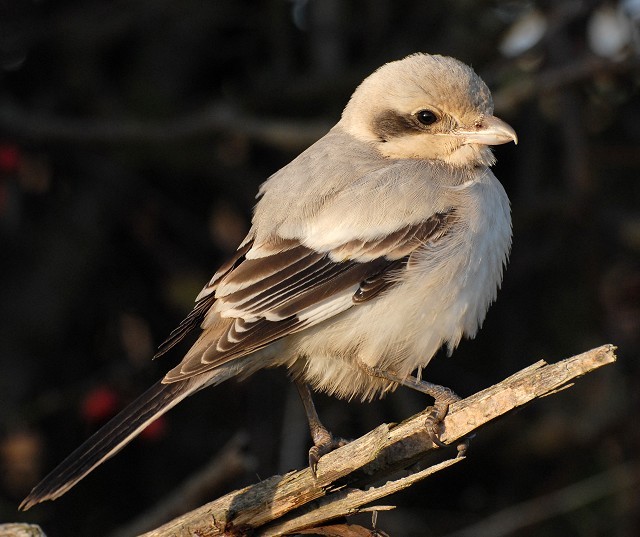
Steppe Grey Shrike, Grainthorpe Haven, Lincolnshire (Photo: Jon Evans)

Hooded Merganser, Radipole Lake RSPB, Dorset (Photo: Gary Thoburn)
The much-talked-about presumed first-winter Brown Shrike near Vallay Strand, North Uist (Outer Hebrides) was seen again on 24th, a full six days since its only other sighting. Adverse weather had precluded too many thorough searches, but persistence paid off with its rediscovery. This time around, a better set of photos seem to provide enough evidence to convince doubting voices that it was indeed a Brown rather than "Turkestan" Shrike. There is, though, the odd key feature, such as the tail shape, which still doesn't appear 100% right for Brown. The touch-tame first-winter Steppe Grey Shrike at Grainthorpe Haven (Lincolnshire) remained to 26th and provided many with the opportunity to take the rarity photographs of a lifetime. The methods by which some of these photographs have been obtained has sparked much debate on the Internet: a whole host of finger-pointing and name-calling has tried hard to overshadow a wonderful vagrant. Thankfully, the bird is rather more impressive than the somewhat tedious bouts of ego-fuelled photographer-rage. In Dorset, the drake Hooded Merganser at Radipole Lake (Dorset) continued to indulge visitors until 26th. Last week, the review carried news of the return of the drake Barrow's Goldeneye to Quoile Pondage in Northern Ireland. Subsequent visits have yielded nothing and it appears that last week's sighting was unconfirmed.

Grey Phalarope, Covenham Reservoir, Lincolnshire (Photo: anon)
The adult White-billed Diver remained off South Ronaldsay (Orkney) until 22nd, looking destined to stay in Orcadian seas for the winter now. With barely a shearwater of note to mention, let's skip straight to Grey Phalarope, a dozen of which were seen during the week, including popular single birds at Cley Marshes (Norfolk) and Covenham Reservoir (Lincolnshire). Two birds were seen from Holme (Norfolk) on 23rd and two were off Cruisetown Strand (Co. Louth) the previous day. Three late Sabine's Gulls were seen off Hawker's Cove (Cornwall) on 23rd while Pomarine Skuas included one off Worthing (West Sussex) on 23rd and three from Holme on 24th. Two Leach's Storm-petrels were seen off Hilbre Island (Cheshire) on 21st. The late northerly gales produced around 30 Little Auks during the week, from County Durham to Kent, with 10 birds seen in Norfolk, six of them passing Sheringham on 22nd.

Cattle Egret, Milnthorpe, Cumbria (Photo: Michael Foley)

Common Crane, Modbury, Devon (Photo: Gary Thoburn)

Night Heron, Hythe, Kent (Photo: Brian Harper)
The Cattle Egret was still at Urswick (Cumbria) throughout the week, and on 23rd, two more were seen in the county, near Milnthorpe, both remaining to 26th. Also on 26th, four birds were seen at Shapwick Heath (Somerset). The Great White Egret was still being seen around Blashford Lakes (Hampshire) from 20th–23rd at least, while 16 Spoonbills were seen at Arne (Dorset) on 23rd. In Essex, the juvenile Spoonbill was again at Abberton Reservoir on 22nd, with one still at the National Wetlands Centre (Carmarthenshire) on 23rd, when another was seen near King's Lynn (Norfolk). On 25th, a Spoonbill was seen on Samson (Scilly), with singles at Cliffe Pools (Kent) and Wacker Quay (Cornwall) on 26th. The White Stork was still being seen at Glascoe Dubh (Isle of Man) from 20th–22nd and the Glossy Ibis was again at Warton Marsh (Lancashire) on 25th–26th. The Common Crane remained at Modbury (Devon) until 25th and, in Suffolk, seven Cranes were seen at Westleton Heath and Minsmere on 24th, with 24 birds counted at the Stubb Mill roost in the Norfolk Broads on 23rd. With just over a fortnight since the departure of the Green Heron, the Royal Military Canal at Hythe (Kent) hosted another impressive (though considerably commoner) heron species, in the guise of a handsome adult Night Heron found on 22nd and still present on 23rd.

Red-breasted Goose, Pennington Marshes, Hampshire (Photo: Doug Kelson)

Cackling Canada Goose, Caerlaverock WWT, Dumfries & Galloway (Photo: Mike Thrower)

Cackling Canada Goose, Caerlaverock WWT, Dumfries & Galloway (Photo: Kris Gibb)

Black Brant, Killala, Mayo (Photo: Dermot Breen)
The adult Red-breasted Goose was still at Pennington Marshes (Hampshire) from 20th–23rd and then headed to Normandy Marsh on 26th. The Cackling Canada Goose remained at Caerlaverock (Dumfries & Galloway) from 20th–25th at least and a Richardson's Canada Goose was still in Argyll, on Islay, at Loch Gruinart on 25th. A Canada Goose species was seen at the North Slob (Co. Wexford) on 22nd. A white Snow Goose was again at Craobh Haven (Argyll) on 21st–23rd with another appearing at West Harford and then Holywell Pond and Holywell Dene (Northumberland) between 22nd and 26th. In Pembrokeshire, a possible Grey-bellied Brant was seen on the Gann Estuary on 23rd–24th, having first been noted the previous week. A Black Brant was again at Titchwell (Norfolk) off and on during the week, and the regular wintering bird was at Gosport (Hampshire) on 26th. Four Brants were seen in Ireland: two remained at Dungarvan (Co. Waterford) to 21st, one was Culleenamore Strand (Co. Sligo) on 22nd and on 23rd one was again at Killala (Co. Mayo).

Green-winged Teal, Caerlaverock WWT, Dumfries & Galloway (Photo: Kris Gibb)
The adult drake Lesser Scaup at Holme Pierrepoint (Nottinghamshire) and Hogganfield Loch (Clyde) both remained to 26th. A first-winter drake was seen at Frampton-on-Severn (Gloucestershire) on 22nd–25th and was presumably the bird seen previously at Lydney. A female Lesser Scaup reappeared on Loe Pool, Helston (Cornwall) on 25th–26th. The female Ring-necked Duck was still at Whitlingham Lane, near Norwich (Norfolk) until 22nd and a female was at Angliham (Co. Galway) on 25th. The drake at Foxcote Reservoir (Buckinghamshire) was seen on 22nd, and another drake was seen at Dooniskey Reservoirs (Co. Cork) on 22nd. Another Irish drake was seen at Lough Gash Turlough (Co. Clare) on 23rd and in Scotland, the drake Ring-necked Duck was still on Loch Bhasapol, Tiree (Argyll) on 24th. In Wales, the drake Ferruginous Duck was still at Cosmeston Lakes (Glamorgan) from 20th–23rd. There were four drake American Wigeon to report this week: in Berkshire, one was found at Lower Farm Gravel Pit on 19th and remained until 23rd at least. Another remained on Loch Bee, South Uist (Outer Hebrides) to 26th, while in Ireland, singles were seen at Lee Reservoirs (Co. Cork) to 23rd and in Shannon Harbour (Co. Offaly) on 26th. At least eight Green-winged Teal were seen during the week, two in England (at Inner Marsh Farm in Cheshire and Alkborough Flats in Lincolnshire), three in Scotland (at Capringstone Flash in Ayrshire, Caerlaverock in Dumfries & Galloway and Kinneil Lagoons in Forth) and three in Ireland (at Belfast Lough, Kilcoole in County Wicklow and Bell Harbour in County Clare). The adult female Surf Scoter remained off Dawlish Warren (Devon) all week and another female was seen at Hough Bay, Tiree (Argyll) on 24th. Two drake Surf Scoters were seen in Lunan Bay (Angus) on 24th with a single male off Ruddon's Point (Fife) on 25th. In Ireland, a juvenile remained off Doonbeg (Co. Clare) to 26th.
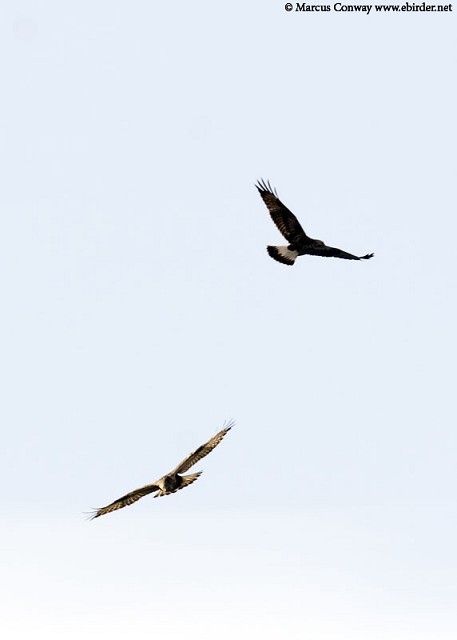
Rough-legged Buzzard, Pocklington, East Yorkshire (Photo: Marcus Conway)
A Snowy Owl was seen at Lochmaddy, North Uist (Outer Hebrides) on 20th, while further Arctic wanderers included at least seven Rough-legged Buzzards seen during the week. The second-winter male remained at Reed (Hertfordshire) to 26th, and the bird at Farforth (Lincolnshire) was still present on 25th, with one at Dorrington Fen on 26th. Last week's two birds at Pocklington (East Yorkshire) became three on 20th, with the adult female and two juveniles still present to 26th. The final birds of the week were at Horsey (Norfolk) and Leighton Moss (Lancashire) on 22nd.

Spotted Sandpiper, Tittesworth Reservoir, Staffordshire (Photo: Dave Hutton)
Two first-winter Spotted Sandpipers were discovered this week. On 22nd, one was found at Tittesworth Reservoir (Staffordshire), the bird remaining to 26th. This was the third record for the county following birds at Belvide Reservoir in 1982 and 2005. The second bird of the week was found at Gyles Quay, Dundalk (Co. Louth) on 24th–26th. Further new arrivals this week included the White-rumped Sandpiper seen for twenty minutes at Alkborough Flats (Lincolnshire) on 23rd and an American Golden Plover at North Duffield Carrs (North Yorkshire) on 20th. The first-winter Long-billed Dowitcher was still at Loch Bee, South Uist (Outer Hebrides) on 22nd, before moving to West Gerinish the following day. The Pectoral Sandpiper was still at Lough Brickland (Co. Down) from 21st–25th.

Caspian Gull, Stubber's Green, West Midlands (Photo: Philip Parsons)
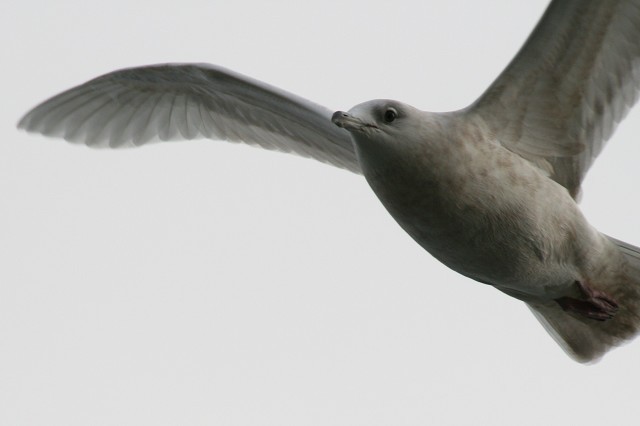
Iceland Gull, Newlyn, Cornwall (Photo: Gordon Hodgson)

Iceland Gull, Lerwick, Mainland, Shetland (Photo: Steve Minton)

Glaucous Gull, Donna Nook, Lincolnshire (Photo: Jamie Macarthur)
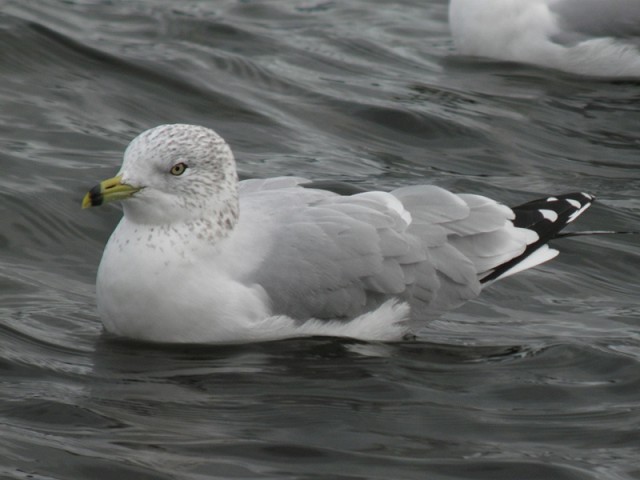
Ring-billed Gull, Nimmo's Pier, Galway (Photo: Dermot Breen)
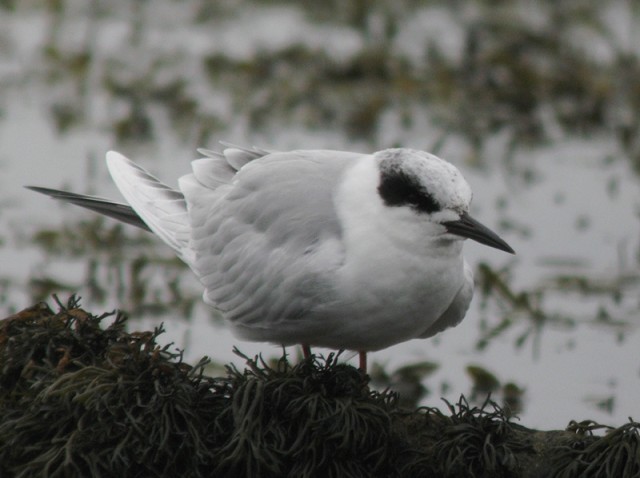
Forster's Tern, Nimmo's Pier, Galway (Photo: Dermot Breen)
Despite losing its true mega status long ago, there is no doubt that Ivory Gull has still got "it" and then some...and with the first blast of Arctic air this week, a typically glorious spotty youngster arrived, albeit briefly, at Seafield, near Lerwick (Shetland) on 21st. It did hang around long enough for a handful of record shots to be fired off. Caspian Gulls saw a notable rise in numbers this week, with at least 27 seen, at least seven of them in Kent, including five different birds at Dungeness and three adults on the RSPB reserve there on 23rd. Three different birds were seen at Calvert Lakes (Buckinghamshire); single sites in Staffordshire, Northamptonshire and Suffolk boasted two birds each; and the third-winter at Potteric Carr (South Yorkshire) was seen to 25th. It was no surprise this week, given the brief Arctic blast of air, that numbers of white-winged gulls rocketed. At least 45 Iceland Gulls were reported, with up to 10 birds around Shetland during the week. Up to 50 Glaucous Gulls were seen, including three off Overstrand (Norfolk) on 22nd (Norfolk recording at least seven birds in the week) and three on Unst (Shetland) on 22nd and 24th (with at least eight birds seen around Shetland this week). Up to five different birds were in Cleveland and three were seen in Suffolk and Northumberland. Up to 20 Ring-billed Gulls were seen during the week, including two first-winter birds in Cornwall (at Helston on 22nd–26th and at Padstow on 23rd), an adult at Nor Marsh (Kent) on 22nd, and further adults at Seaforth (Lancashire) on 20th and Chew Valley Lake (Somerset) on 23rd, while "new" returning adults were at Oban (Argyll) from 21st and on the Isle of Dogs (London) on 22nd. In Ireland, at least nine birds were seen, including three adults at Nimmo's Pier (Co. Galway) on 22nd and an adult and second-winter at Clonakilty (Co. Cork) on 24th. The adult Forster's Tern remained off Nimmo's Pier to 22nd at least.

Desert Wheatear, Girdle Ness, Aberdeenshire (Photo: Chris Jones)

Great Grey Shrike, Lakenheath, Suffolk (Photo: Jon Evans)

Hoopoe, Traught Beach, Galway (Photo: Dermot Breen)
What may prove to be Lincolnshire's first Black-throated Thrush, a male, was seen to fly in off the sea, before landing briefly and heading into the dunes at Skegness on 22nd. The first-winter male Desert Wheatear of two weeks ago was relocated at Girdle Ness (Aberdeenshire) on 24th–26th, the third record of the species here in the past 11 years. In Ireland, a Hoopoe was found at Traught Beach (Co. Galway) on 24th and remained to 26th. A Richard's Pipit flew over Freckleton Haze (Lancashire) on 22nd. Up on Orkney, observers hoping to confirm the identity of a silent first-winter pipit seen on North Ronaldsay on 21st and 24th had to wait until the bird was trapped on 25th to have its identity confirmed. Initially it was hard to tell from the images taken whether it was a Blyth's Pipit or a Richard's Pipit, but in the hand, the bird proved to be the latter and not the much rarer species. The third Richard's Pipit of the week was seen at Cwm Nash (Glamorgan) on 26th. Seven counties hosted Great Grey Shrikes during the week, with up to three birds in the New Forest (Hampshire), single birds at Wishmoor Bottom (Berkshire) to 20th, and again at Lakenheath (Suffolk) on 25th–26th. New arrivals appeared at Aldcliffe Marshes (Lancashire) on 23rd, Glasfynydd Forest (Powys) on 24th (though this bird has first been noted at the end of last week) and at Vane Farm (Perth & Kinross) and near Dalwhinnie (Highland), both on 25th.

Waxwing, Dumfries, Dumfries & Galloway (Photo: Mike Thrower)
Thousands of Waxwings continued to be seen around the country, and Scotland continued to dominate. At least 650 birds were seen around Glasgow (Clyde) on 24th, easily the highest number seen so far this winter. On 20th, 150+ were in Dumfries (Dumfries & Galloway) and 100 were in Edinburgh (Lothian). The 21st saw a flock of 300 counted in Aberdeen, 200 birds in Dunblane (Forth) and 120 at Bathgate (Lothian). On 22nd, 120 or so were seen at Musselburgh (Lothian) and 200+ were at Motherwell (Clyde) on 23rd. The 24th saw a flock of 100 at Cumnock (Ayrshire), with 100+ at Hamilton (Clyde) on 26th. In England, small groups were scattered across East Anglia, the Southeast and the Midlands, while in the Northeast, a flock of at least 350 were seen in Jarrow (Co. Durham) on 21st with 130+ at Stockton-on-Tees (Cleveland) on 22nd. Hundreds of birds were noted in the Northwest, with 100 at Penrith (Cumbria) on 21st, up to 90 in Carlisle (Cumbria) on 23rd and 54 in Preston (Lancashire) on 24th. The largest flock south of the border was seen at Dalston (Cumbria) on 26th, where 210+ were seen. Three Welsh counties hosted Waxwings during the week including 12 at Deganwy (Conwy) on 24th–25th, while in Ireland, 80 birds were noted at Portstewart (Co. Derry) and Lisburn (Co. Antrim) on 24th and 82 were counted at Coleraine (Co. Derry) on 25th. Seven birds were seen in Dublin (Co. Dublin) on 23rd.

Red-breasted Flycatcher, Leagrave Marsh, Bedfordshire (Photo: Andy Whitney)
The sometimes-showy female Sardinian Warbler remained at Berry Head (Devon) to the morning of 21st. A Barred Warbler was found at Fethard-on-Sea (Co. Wexford) on 25th and single Yellow-browed Warblers were on Bardsey Island (Gwynedd) on 19th and Hartlepool Headland (Cleveland) and St. Mary's (Scilly) on 21st. Something of a surprise was the inland Red-breasted Flycatcher at Leagrave Marsh in suburban Luton (Bedfordshire) on 23rd–26th, the county's first proven record.
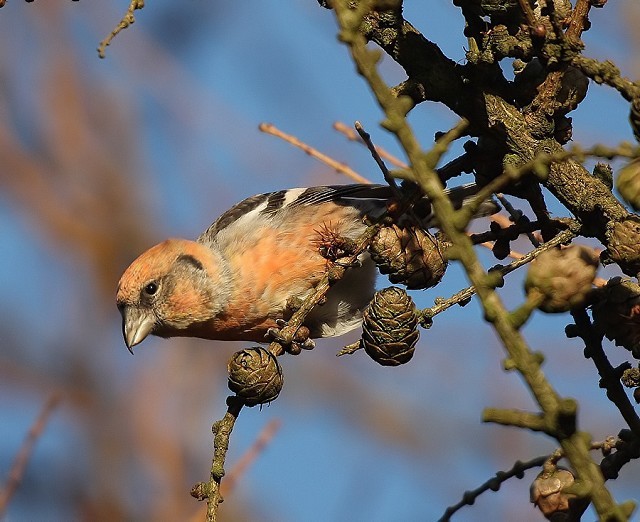
Two-barred Crossbill, Bilsdale, North Yorkshire (Photo: Dave Hutton)
The male Two-barred Crossbill was last seen near Bilsdale (North Yorkshire) on 23rd. At Rainham Marshes (London), three Serins were still present on 20th, with one still present to 25th. A Common Rosefinch was found feeding in sharp-eyed birders' gardens around Whitburn (Co. Durham) during the week and the Rose-coloured Starling was still in Newquay (Cornwall) to 26th. Finally this week, a Little Bunting was trapped and ringed at Knott End (Lancashire) on 26th.
Photo of the Week
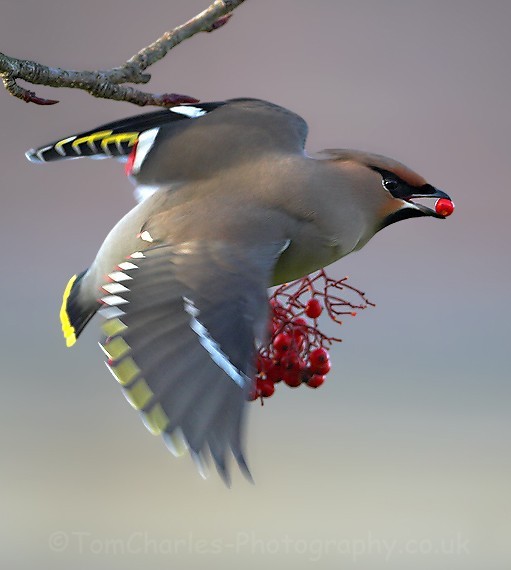
Waxwing, Barrow, Lancashire (Photo: Tom Charles)
Waxwings are one of those bird species that just seem too exotic to be found in Britain. This winter, though, has seen good numbers across the country, providing plenty of photo opportunities. Perhaps unsurprisingly, we've had more photos of Waxwings uploaded than any other species by far: almost 1000 photos. That said, as many a frozen-fingered photographer has found, getting good images of these birds can be frustratingly difficult. With a beautifully-composed image, Tom Charles has captured the characteristic feeding action. The perfect pose, the strong focal point provided by the head and berry, and the splashes of colour set against a muted background 'wash' give the image the look of a classic bird painting.
Other notable photos

Steppe Grey Shrike, Grainthorpe Haven, Lincolnshire (Photo: Dean Eades)

Barn Owl, undisclosed site, Lancashire (Photo: David Cookson)

Iceland Gull, Lerwick, Mainland, Shetland (Photo: Steve Minton)

Short-eared Owl, Pymoor, Cambridgeshire (Photo: Garth Peacock)

Common Kestrel, Meols, Cheshire (Photo: Mike Atkinson)

Great Northern Diver, West Kirby Marine Lake, Cheshire (Photo: Steve Round)

Tufted Duck, Wigan Flashes LNR, Manchester, Greater (Photo: Mike Atkinson)

Pied Wagtail, Alford, Aberdeenshire (Photo: Alan Sinclair)

Goldfinch, Llandrindod Wells, Powys (Photo: Kev Joynes)

Linnet, Summer Leys LNR, Northamptonshire (Photo: Matthijs Ravensberg)

Woodcock, Howey, Powys (Photo: Paul_leafe)

Nuthatch, Dunham Massey NT, Cheshire (Photo: Damian Waters)
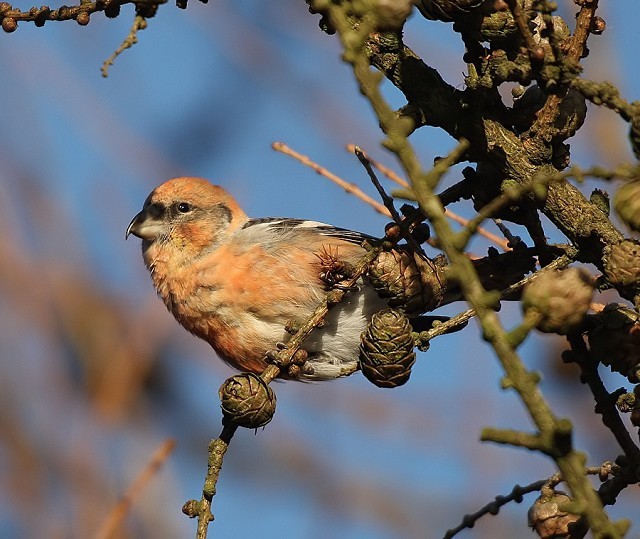
Two-barred Crossbill, Bilsdale, North Yorkshire (Photo: Dave Hutton)

Purple Sandpiper, Ogmore-by-Sea, Glamorgan (Photo: Stevehinton)
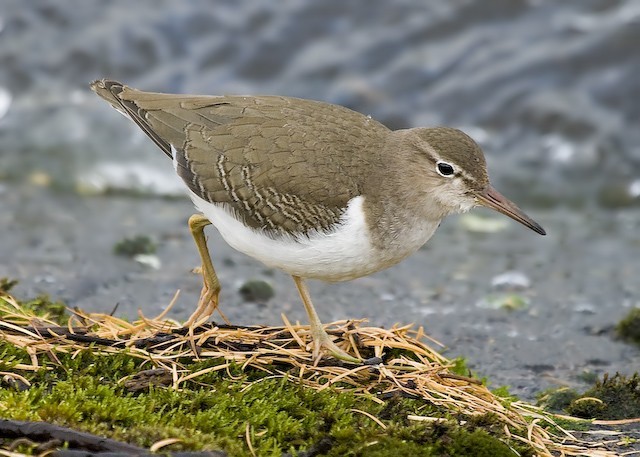
Spotted Sandpiper, Tittesworth Reservoir, Staffordshire (Photo: Jon Lowes)
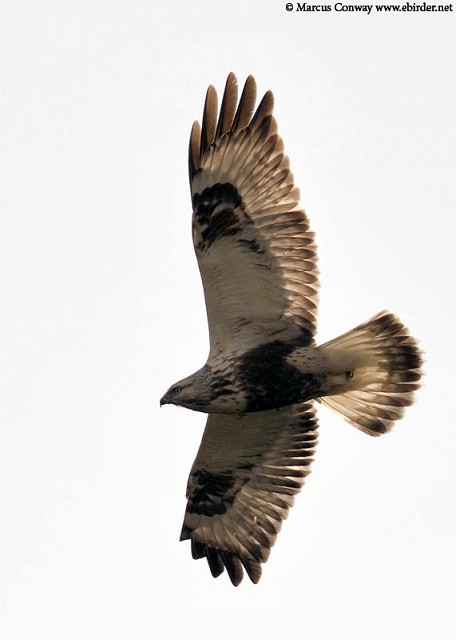
Rough-legged Buzzard, Pocklington, East Yorkshire (Photo: Marcus Conway)

Lesser Redpoll, Llandrindod Wells, Powys (Photo: Paul_leafe)

